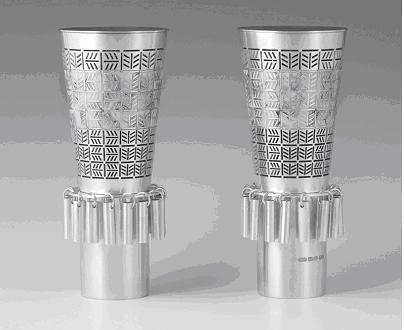scroll and ornamentsBased on an article by Gordon Barclay published in Liberal Judaism in 2004
On 5th September 2004, over 18 months of hard work culminated in the arrival of the first Torah scroll of the Edinburgh Progressive Jewish Community (‘Progressive’ because, at that time, we had yet to decide whether to affiliate to Reform or Liberal movements). There has been a Reform community of some kind in Edinburgh, off and on, for almost 30 years. From 1997, with generous assistance from Rabbi Pete Tobias and Glasgow New Synagogue (GNS), the Community took more formal shape and began to grow.
By early 2003 the Community was holding regular monthly Erev Shabbat services and occasional Torah services, with a scroll lent by GNS. But the logistical problems of transporting the scroll were considerable. By this stage the Community, while still very much attached to GNS, felt that it needed some of the things locally that a Jewish community should have - a Cheder, for example, had been started in 2002.
The feeling began to grow that the Community needed its own Torah scroll, both for practical reasons, for services, and to act as a focus. Could we afford one? So it was that we began to explore some strange byways....did you know you can buy a Torah on e-bay? There was much discussion about what we wanted - we couldn’t afford a new scroll - writing a new one can cost well over £20,000. And we knew we’d have to brave the ‘pre-owned’ market. We knew we wanted an Ashkenazi text, and that we also needed a light scroll which could be lifted by any member of our community – old or young, male or female. Of course, the lighter scrolls cost more!
The Czech Torah Scroll Trust was our first stop; the Trust, as many readers will know, has repaired and sent our on permanent loan many hundreds of scrolls rescued from Czechoslovakia in 1964. Unfortunately nothing usable or repairable was left in their collection. We began to look further afield.
Rabbi Tobias made contact with a rabbi at a conference in the United States - a man who could apparently source scrolls from all over the world, at low prices. We came and went with this rabbi for a while, but we didn’t want to buy sight unseen, and the problems of bringing the scroll to Britain were considerable. I’ll never forget my Kafkaesque telephone conversations with Customs and Excise about the basis for charging duty on a scroll imported from the USA – it’s a work of religious art, should you need it for a shul quiz!
Finally we made contact with a sofer in Britain, Marc Michaels, whose working name is Mordechai Pinchas. At first we sought only advice, which he generously provided, as to what a small community might be able to buy. And then we asked him to act for us. At first the scrolls he could find available for sale were either too large or too expensive, or both. At last, however, in late November 2003 he sent us photos of what seemed the perfect scroll: 85cm long high, with the parchment 42cm wide, and weighing 3.6kg (8lbs).
It needed repairs of course to make it kasher but the scroll and the repairs together would cost a figure most of us felt we could raise from within the community. Rabbi Tobias (now based in Elstree) went to inspect the scroll, and he pronounced it fit for use, subject to the repairs being completed.
The history of our new scroll is as yet obscure. Before work had started Marc had thought that it was made up of two pre-existing scrolls, a not uncommon practice. However, his close scrutiny has shown that the hand is the same throughout. Marc writes that the stitching of the yeriot is in the 200 year style so this and the fact it does not follow the standard 42 line ktav tikkun suggests it is at least 150 years old. The script is German, Bet Yosef.
As soon as the Edinburgh Community formally became independent and resoundingly confirmed the decision to buy the scroll, we asked Marc to act on our behalf to buy the scroll and undertake the repairs, and started to raise funds. In the end, the generosity of members of the community and other Jews associated with the Community ensured that the sum for the purchase of the scroll, its repair, and its dressings was collected by the beginning of August. At the Siyyum (‘completion’) service on 5th September the oldest and youngest members of our congregation will complete the last two letters and the scroll was ready for use, for the first time, at the Community’s first High Holy Day services.
The ornaments made of sterling silver, enamel and gold foil were made for us by Israeli jeweller and silversmith Tamar de vries Winter, thanks to a generous donation. The rimonim, illustrated above, are fringed with oval tubes, ‘Rather than using traditional bells I was inspired by wind chimes in a tree,’ said the Cambridge-based artist. ‘It’s less fussy and a gentler sound.’ The breastplate is inscribed with the Hebrew text that includes the words Sukkat Shalom (Shelter of Peace). The Community celebrated the addition of the rimonim and accompanying breast plate at a special Shabbat service in June 2005. |



 The photograph on the right shows the rimonim (Torah finials - literally pomegranate in Hebrew) that decorate our Torah Scroll during services. See the last paragraph of this article.
The photograph on the right shows the rimonim (Torah finials - literally pomegranate in Hebrew) that decorate our Torah Scroll during services. See the last paragraph of this article.